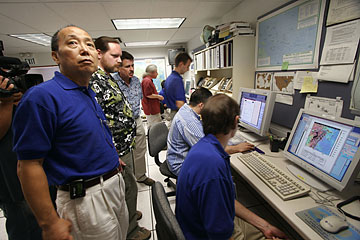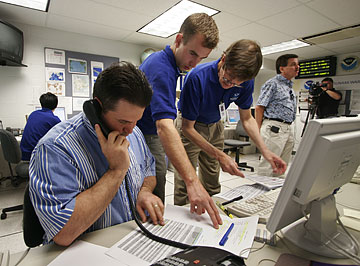
DENNIS ODA / DODA@STARBULLETIN.COM
The Pacific Tsunami Warning Center in Ewa Beach conducted its first Pacific-wide tsunami warning exercise yesterday. During the drill, an actual earthquake occurred in Indonesia, and officials set to monitoring it for a possible tsunami. They included Vindell Hsu, left, Nathan Becker, center Director Charles McCreery, Barry Hirshorn, Brian Shiro, Victor Sardina and Gerard Fryer.
|
|
Quake watch
Multiple real earthquakes in the Pacific region underscore the necessity of a tsunami drill
IMAGINE a 21-foot-tall tsunami hitting Hilo Harbor as a Category 4 hurricane with 155-mph winds approaches the islands.
That's what planners at the state Civil Defense headquarters in Diamond Head were dealing with yesterday during a first-ever international tsunami drill that also coincided with the state's annual hurricane exercise.
"Tsunamis are a 24-hour-a-day, seven-day-a-week threat, so it's conceivable that it could happen," said state Civil Defense spokesman Ray Lovell, explaining why the state participated in both the tsunami drill and the hurricane exercise yesterday.
"It gives us an idea of how to deal with a kind of double-whammy," Lovell said.
The international tsunami drill involved a fictional 9.2 magnitude earthquake off Chile yesterday morning. A tsunami from the same area killed 61 people in Hilo in 1960.
Another test for western Pacific countries yesterday afternoon involved a mock 8.8 magnitude earthquake off the Philippines.
At the start of the test just after 9 a.m., a beeping sound filled the Pacific Tsunami Warning Center in Ewa Beach, signaling a mock earthquake off the coast of Chile. Pre-planned messages clearly marked as a drill went out through satellite networks, phone lines, e-mail, and faxes to about 35 different countries.
Charles "Chip" McCreery, director of the warning center, said the drill tested the ability of other countries to receive tsunami messages from the center and of their procedures to get the information to the public.
"We're just the start of a chain of events, and if the chain is broken anywhere along the line, it's not going to work," he said.
In Hawaii, the drill was limited to state and county emergency officials, who went through a list of 19 state agencies to make sure all would be properly warned about the tsunami and hurricane.
American Samoa, Malaysia, Thailand and the Philippines actually practiced evacuations of civilians as part of the drill.
In the Philippines, nearly 1,000 residents staged a mock evacuation in the far-flung coastal village of Buhatan, 210 miles southeast of Manila. Just after dawn, village leaders used a stone and a hammer to ring the bells of a small church, signaling the start of the exodus. Villagers then streamed out of their homes, tugging children and struggling to carry bamboo mats, hammocks, coffee pots and roosters.
McCreery said there were a few minor glitches in the international drill.

DENNIS ODA / DODA@STARBULLETIN.COM
Victor Sardina, left, Brian Shiro, Gerard Fryer and Charles McCreery, director of the Pacific Tsunami Warning Center, monitored the computer data during yesterday's Pacific-wide drill.
|
|
Some countries had not updated their contact list before the drill, so the center did not have correct phone numbers when they tried to follow up with phone calls to officials.
However, during an actual tsunami, the center may not have enough staff to make calls to each country affected, McCreery said.
"We would like to call people if we can, but it's not a guarantee," he said.
A noticeable difference between the exercise and a real event was that the phones in the center were silent. Normally, as soon as warnings go out, the center is flooded with calls from government officials and media from around the world, with the scientists trying to answer questions while monitoring seismic activity on their computer monitors.
As if to emphasize the reason for the test yesterday, several real earthquakes hit the Pacific region before and during the test, including an aftershock from the Tonga earthquake earlier this month and an earthquake north of New Zealand that generated a minor local tsunami yesterday.
There were also three quakes off the coast of Indonesia.
A magnitude 5.8 earthquake rattled Tonga at the same time that emergency authorities on the country's islands were broadcasting simulated earthquake alerts as part of the Pacific-wide simulation. The quake was the latest in a string of aftershocks to hit the country since a powerful 7.8 quake on May 4 that generated a small nondestructive tsunami.
Tonga's National Disaster Office deputy director, Mali'u Takai, said people in the Ha'apai island group near the epicenter of yesterday's quake felt the ground move as officials were broadcasting mock tsunami warnings.
The National Disaster Office was "bombarded with questions" as the quake hit in the midst of the tsunami test, Takai said. He added that authorities should have done more to make clear to residents that the warnings, broadcast on local radio stations, were part of a test.
McCreery said interest in yesterday's test can be attributed to the December 2004 tsunami in the Indian Ocean that left at least 216,000 people dead or missing and led to international calls for a better warning system.
"We viewed it (yesterday's drill) as a success before the exercise started because of so much interest in participating," McCreery said. A number of countries that are not part of the 28-nation tsunami-warning system participated in the drill and are looking at developing tsunami warning plans, he said.
Governments will evaluate the drill and report back over the next few weeks to the United Nations Educational, Scientific and Cultural Organization, which organized the test. Officials hope that the drill will become an annual event.
Star-Bulletin reporter Craig Gima and the Associated Press contributed to this story.

